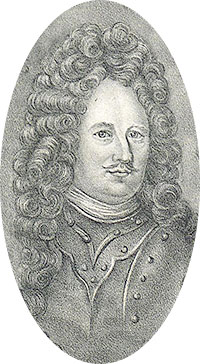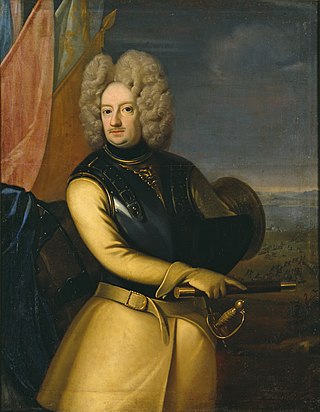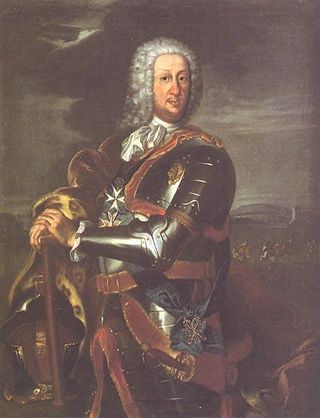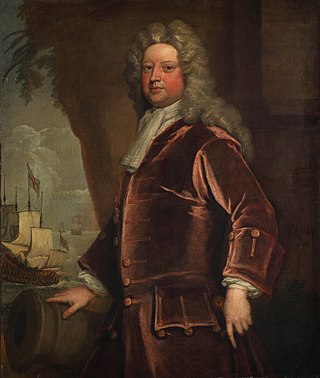
Count Otto Ottoson Vellingk (1649- 1708) was a Swedish general during the Great Northern War. [1]

Count Otto Ottoson Vellingk (1649- 1708) was a Swedish general during the Great Northern War. [1]
He was born in Jama in Swedish Ingria to Otto Gotthardsson Vellingk and Christina Nilsdotter Mannersköld. [2]
In 1664, Vellingk became a lieutenant with the Swedish regiment at Bremen. He subsequently entered French service in 1666 and was promoted in 1670 to Colonel in the French army. He was promoted to general in the Swedish Army during 1698. He participated in key battles of Great Northern War including: the Battle of Narva in 1700, and the Crossing of Daugava near Riga in 1701. He participated in the Battle of Klissow on 9 July 1702. [3] He was in the Battle of Punitz on 28 October 1704. [4] He was made a royal advisor in 1705, and ennobled as a count in 1706.

1702 (MDCCII) was a common year starting on Sunday of the Gregorian calendar and a common year starting on Thursday of the Julian calendar, the 1702nd year of the Common Era (CE) and Anno Domini (AD) designations, the 702nd year of the 2nd millennium, the 2nd year of the 18th century, and the 3rd year of the 1700s decade. As of the start of 1702, the Gregorian calendar was 11 days ahead of the Julian calendar, which remained in localized use until 1923.

The Great Northern War (1700–1721) was a conflict in which a coalition led by the Tsardom of Russia successfully contested the supremacy of the Swedish Empire in Northern, Central and Eastern Europe. The initial leaders of the anti-Swedish alliance were Peter I of Russia, Frederick IV of Denmark–Norway and Augustus II the Strong of Saxony–Poland–Lithuania. Frederick IV and Augustus II were defeated by Sweden, under Charles XII, and forced out of the alliance in 1700 and 1706 respectively, but rejoined it in 1709 after the defeat of Charles XII at the Battle of Poltava. George I of Great Britain and the Electorate of Hanover joined the coalition in 1714 for Hanover and in 1717 for Britain, and Frederick William I of Brandenburg-Prussia joined it in 1715.

The Battle of Narva on 30 November [O.S. 19 November] 1700 was an early battle in the Great Northern War. A Swedish relief army under Charles XII of Sweden defeated a Russian siege force three to four times its size. Previously, Charles XII had forced Denmark–Norway to sign the Treaty of Travendal. Narva was not followed by further advances of the Swedish army into Russia; instead, Charles XII turned southward to expel August the Strong from Livonia and Poland-Lithuania. Tsar Peter the Great of Russia took Narva in a second battle in 1704.

Count Erik Jönsson Dahlbergh was a Swedish military engineer, Governor-general and Field marshal. He rose to the level of nobility through his military competence. According to Cathal Nolan, Count Dahlberg was a highly innovative military engineer in the 17th and 18th century, often referred to as the "Swedish Vauban". He was expert in both building and destroying fortifications. In warfare he won several sieges, including Copenhagen and Kronborg. He famously led a Swedish army across the frozen Great and Little Belts to attack Copenhagen. Dahlberg commanded Swedish engineers in several wars and his historic influence was ensured vika his skill at map-making, the fortresses he designed, and his widely read writings on military architecture. Today he is well known through his Suecia Antiqua et Hodierna, a collection of engravings of topographical research.

Count Magnus Stenbock was a Swedish field marshal (Fältmarskalk) and Royal Councillor. A renowned commander of the Carolean Army during the Great Northern War, he was a prominent member of the Stenbock family. He studied at Uppsala University and joined the Swedish Army during the Nine Years' War, where he participated in the Battle of Fleurus in 1690. After the battle, he was appointed lieutenant colonel, entered Holy Roman service as Adjutant General, and married Eva Magdalena Oxenstierna, daughter of statesman Bengt Gabrielsson Oxenstierna. Returning to Swedish service he received colonelcy of a regiment in Wismar, and later became colonel of the Kalmar and then Dalarna regiments.

Count Boris Petrovich Sheremetev was an Imperial Russian diplomat and general field marshal during the Great Northern War. He became the first Russian count in 1706. His children included Pyotr Sheremetev and Natalia Sheremeteva.

Joachim von Rohr was a lieutenant colonel for the Swedish Empire and Commandant of the Dalarö fortress. He participated in the Battle of Poltava and was captured and held as a prisoner of war in Solikamsk in Russia.

Admiral of the Fleet Sir John Norris was a Royal Navy officer and Whig politician. After serving as a junior officer during the Nine Years' War and the Williamite War in Ireland, he was given command of a squadron sent to North America to protect British settlements on the banks of Hudson Bay in 1697. Although he developed a plan to recapture some territories in Newfoundland and Labrador taken by French forces the previous winter, he was prevented from implementing that plan when the local council overruled him.
The Nyland and Tavastehus County Cavalry Regiment was a Swedish Army cavalry regiment located in the county of Nyland and Tavastehus that traced its origins back to the 17th Century. It was split in 1791.

Anders Örbom was a captain in the Swedish Army who was at the Surrender at Perevolochna and taken to Siberia as a prisoner of war for 13 years.

Count Carl Gustav Rehnskiöld was a Swedish Field Marshal (fältmarskalk) and Royal Councillor. He was mentor and chief military advisor to King Charles XII of Sweden, and served as deputy commander-in-chief of the Carolean Army, an army he assisted both in its education and development.

The Battle of Kliszów took place on July 19, 1702, near Kliszów in the Polish–Lithuanian Commonwealth during the Great Northern War. A numerically superior Polish–Saxon army led by king Augustus II the Strong was defeated by a Swedish army half its size under the command of king Charles XII of Sweden.
Adam Heinrich Graf von Steinau was a Saxon Generalfeldmarschall.
Arthur Dillon, Count Dillon (1670–1733) was a Jacobite soldier from Ireland who served as colonel of Dillon's Regiment in the Irish Brigade in French service. He fought in the Nine Years' War and in the War of the Spanish Succession where he excelled at the Battle of Cremona against Prince Eugene of Savoy.
Rudolf Ritter von Otto began his military career in the army of the Electorate of Saxony, transferred to the Austrian army and had a distinguished combat record during the Seven Years' War and the French Revolutionary Wars.

Jakob Heinrich von Flemming was a Saxon count, military officer and politician. He was born in Hoff, Prussian Province of Pomerania to a noble family. He completed his law studies in 1688, after which he entered service with Brandenburg. He attained the rank of general in 1705 and Generalfeldmarschall in 1711.

Events from the year 1702 in Sweden
George Bogislaus Staël von Holstein was a Swedish baron and field marshal. He was the Governor of Malmöhus County from 1754 to 1763.
Henrik Otto von Albedyll, was a Swedish freiherr and military officer of German Baltic origin. In 1719 he was acting General Governor of Swedish Livonia.

Count Carl Gustaf Dücker was a Swedish field marshal (Fältmarskalk) and Royal Councillor.
... who commanded the Swedish right, was mortally wounded,* and his place was taken by General Otto Vellingk. The magnificently attired and excellently mounted Polish cavalry charged the Swedes in gallant style, but were met not only by ...